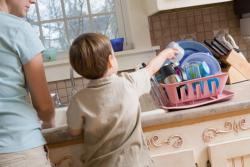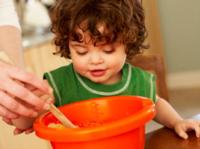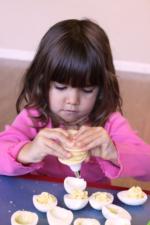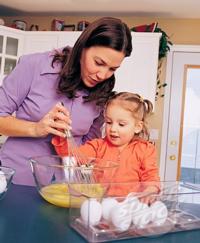
What Can Children Do to Help Out in the Kitchen?
What Can a Two Year Old Do?
 Two year olds are very curious learners. However, they are still learning how to coordinate their muscles, so jobs in the kitchen that use the large muscles of the legs and arms will be most successful.
Two year olds are very curious learners. However, they are still learning how to coordinate their muscles, so jobs in the kitchen that use the large muscles of the legs and arms will be most successful.
Scrubbing:
- Start two year olds with scrubbing the table and work surfaces.
- Set up a tub or sink area where they can scrub vegetables, such as carrots and potatoes.
- Let them wash unbreakable dishes or pots and pans.
- Brushes and sponges will be easier for two year olds than using a cloth.
- Provide an apron or dry clothes and be prepared for spills.
Tearing - Breaking - Snapping:
- Tear lettuce greens for salad.
- Break apart broccoli, cauliflower, and grapes.
- Snap green beans and peas.
- Encourage tasting while they are tearing, breaking, and snapping.
Dipping:
- Serve dips made from dried beans, split peas, peanut butter, and yogurt.
- Serve dips with breads, fruits, and vegetables.
- Dipping is sometimes easier for two year olds than using utensils.
What Can a Three Year Old Do?

Wrapping:
- Cut squares of foil to wrap apples, corn or potatoes.
- Roll out biscuit or pastry dough and cut out shapes to wrap around hot dogs, meat, or other fillings.
Pouring:
- Start with having children pour water at the sink (or in the bathtub).
- Practice pouring liquid from one cup to another.
- Children will want to fill their cups to the brim, which can cause spills. To avoid this, mark the pouring line on the cup with a rubber band or marker.
- Use smaller pitchers, such as measuring cups, for pouring. Show how to hold the pitcher with one hand on the handle and the other hand under the spout.
- Focus on pouring milk, water, and fruit juices, and avoid pouring hot beverages.
Mixing:
- For beginners, start by mixing with clean hands rather than utensils. This is a great way to feel the different textures of bread dough.
- Then try using wooden spoons with easy-to-mix batters.
- To prevent the bowl from slipping, place a damp towel under the bowl or ask another child to hold the bowl.
Shaking:
- Provide small jars with tight-fitting lids.
- Show how to place one hand on the top and one hand on the bottom to shake.
- Fill the jars half-full to make pudding.
What Can a Four Year Old Do?
 Four year olds enjoy doing more things on their own. They are more coordinated now and are working on using their fingers more and increasing their hand coordination.
Four year olds enjoy doing more things on their own. They are more coordinated now and are working on using their fingers more and increasing their hand coordination.
Peeling:
- Start with using fingers rather than sharp equipment to remove the peel from foods.
- Try shucking corn, shelling shrimp, or peeling eggs, oranges, or bananas.
Rolling:
- Start with using the hands and fingers to roll foods.
- Try rolling meatballs or cheese balls rather than the standard cookie dough.
- Show how to flatten the food ball to make it into a circle. Talk about the shapes.
Mashing:
- Start with using a fork to smash soft foods, such as a banana.
- Try using a potato masher to mash larger amounts of foods.
- Next, try using a ricer to create a different type of texture.
- Make egg salad, applesauce, mashed potatoes, or bean dip by mashing.
Juicing:
- Start with squeezing juice from a fruit by hand.
- Try using a hand juicer to squeeze out the juice. Place a damp cloth under the juicer to prevent it from slipping.
- Show how to place a hand on the juicer and the other hand on the fruit.
- Show how to push the top hand down and rotate the fruit.
- Roll the fruit on the counter first to make it easier to juice.
What Can a Five Year Old Do?

Measuring:
- Preschoolers have already been learning about measuring when they started pouring liquids. Now they are ready to learn more.
- Start with measuring spoons. Show how to fill a spoon and then level it with the side of a knife. Show how there are different-sized spoons and point to the writing.
- Show how to use the dry measuring cups to measure out dry ingredients, such as flour, cereal, or pasta. Show how to level the top with the side of a knife.
- Show how to measure wet ingredients with a clear cup. Practice first with water in the sink. See how close children can get to pouring a half-cup, three-fourth cup, etc.
Cutting:
- Start with plastic knives and semi-soft foods, such as eggs, cheese, and bananas.
- Show how to cut using one hand to hold the food (making sure the fingers are not under the blade) and the other hand to hold the knife.
- Place the index finder on the top of the blade and use a slow sawing motion.
Show how to safely pass a knife. - After the above is mastered, children can move onto using small paring knives to cut onions, peppers, and apples.
- Show how to always place the flat surface of the food on the cutting board.
Grating:
- Start with a small square, upright grater, or one that fits securely onto the top of a container.
- Show how to hold one hand on the grater and move the food with the other hand.
- Show how to hold the fingers away from the grater.
- Start with soft foods, such as cheese, apples, or cabbage.
Beating:
- Young children will have learned how to use wire whisks to mix and beat foods.
- Now, they are ready to use an egg beater. Use a non-slip bowl or place on a damp towel.
- Before putting the beater into food, have children practice holding the beater with one hand and turning the handle with the other.
- Start with easy-to-whip foods, such as eggs and smoothies.

